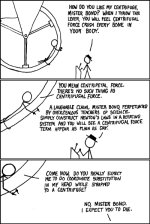There should be a dumb math questions thread.
I'm failing to work out the angle between the sides of a pyramid (constructed with equal triangles), given the angle of the top corner of its individual triangles.
That's fairly easy for me, because I have Mathematica. It does algebra, but I can do analytic geometry with it, even if not Euclid-style constructions.
h = (height) / (half of base length)
cos(angle between edges at the top of the pyramid: a) = h
2 / (1 + h
2)
cos(angle between sides: b) = 1 / (1 + 2*h
2)
h = sqrt(cos(a)/(1 - cos(a))
cos(b) = (1 - cos(a))/(1 + cos(a))
Some time ago, I failed to work out how to derive the directional vector expressed in x-y-z format of a great circle (not in spherical coordinates!), given inclination relative to the sphere's equator (for simplicity, defined as the x-y-plane), angular distance from due east, and angular distance from the ascending node. I did work out the vertical and planar component of that vector, and got away with pretending that the planar component in turn was composed like the two-dimensional vector of an equatorial orbit, but only because I was able to restrict myself to low inclinations where the error thus introduced remained small.
 Orbital elements
Orbital elements has the solution to that problem.
cos(asn)*cos(pla) - sin(asn)*sin(pla)*cos(inc)
sin(asn)*cos(pla) + cos(asn)*sin(pla)*cos(inc)
sin(pla)*sin(inc)
asn = angle from {1,0,0} in the equator to the ascending node
inc = inclination of orbit plane to equator
pla = angle from the ascending node to the object position

